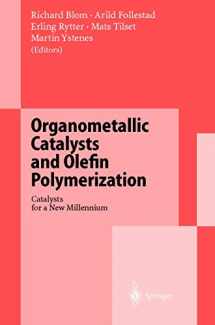
Organometallic Catalysts and Olefin Polymerization: Catalysts for a New Millennium
ISBN-13:
9783642639876
ISBN-10:
3642639879
Edition:
Softcover reprint of the original 1st ed. 2001
Author:
R. Blom, A. Follestad, E. Rytter, M. Tilset, M. Ystenes
Publication date:
2011
Publisher:
Springer
Format:
Paperback
455 pages
FREE US shipping
Book details
ISBN-13:
9783642639876
ISBN-10:
3642639879
Edition:
Softcover reprint of the original 1st ed. 2001
Author:
R. Blom, A. Follestad, E. Rytter, M. Tilset, M. Ystenes
Publication date:
2011
Publisher:
Springer
Format:
Paperback
455 pages
Summary
Organometallic Catalysts and Olefin Polymerization: Catalysts for a New Millennium (ISBN-13: 9783642639876 and ISBN-10: 3642639879), written by authors
R. Blom, A. Follestad, E. Rytter, M. Tilset, M. Ystenes, was published by Springer in 2011.
With an overall rating of 4.4 stars, it's a notable title among other
books. You can easily purchase or rent Organometallic Catalysts and Olefin Polymerization: Catalysts for a New Millennium (Paperback) from BooksRun,
along with many other new and used
books
and textbooks.
And, if you're looking to sell your copy, our current buyback offer is $0.3.
Description
"Catalysis is more art than science", probably all of you have heard and even used this expression. Whether it is true or not, it alludes to the experience that new catalysts are hard to find, and near impossible to predict. Hard work and a lifetime of experience is invaluable. However, a keen mind might give insight into where to search, but not necessarily about where to find the answers. Historically, "quantum leaps" have often arisen from serendipity - we all know the story about the nickel-contaminated reactor that triggered further research towards the first coordination catalyst for ethene polymerization. Taking advan tage of this event, Karl Ziegler became the first chemist to earn both a Nobel prize and a fortune for the same invention. A broken NMR tube helped Walter Kaminsky discover the effect of high concentrations of methylaluminoxanes as co catalysts for metallocenes. When air reacted with the concentrated trim ethyl aluminum solution, sufficient amounts of methylaluminoxanes were formed, and the lazy catalyst dormant in the NMR tube suddenly became sensationally active. Ziegler and Kaminsky were lucky and had the genius needed to take advantage of their luck.


We would LOVE it if you could help us and other readers by reviewing the book
Book review

Congratulations! We have received your book review.
{user}
{createdAt}
by {truncated_author}


